On this day in 1894, Germany’s Tübingen University awarded Ferdinand Kittel an honorary doctorate for his work on the Kannada language. In this detailed essay, Dr Padmanabha Kekunnaya tells how Kittel, born in a small town in Germany, came to create his celebrated ‘Kannada-English Dictionary’ and became one of modern history’s greatest Kannadigas.
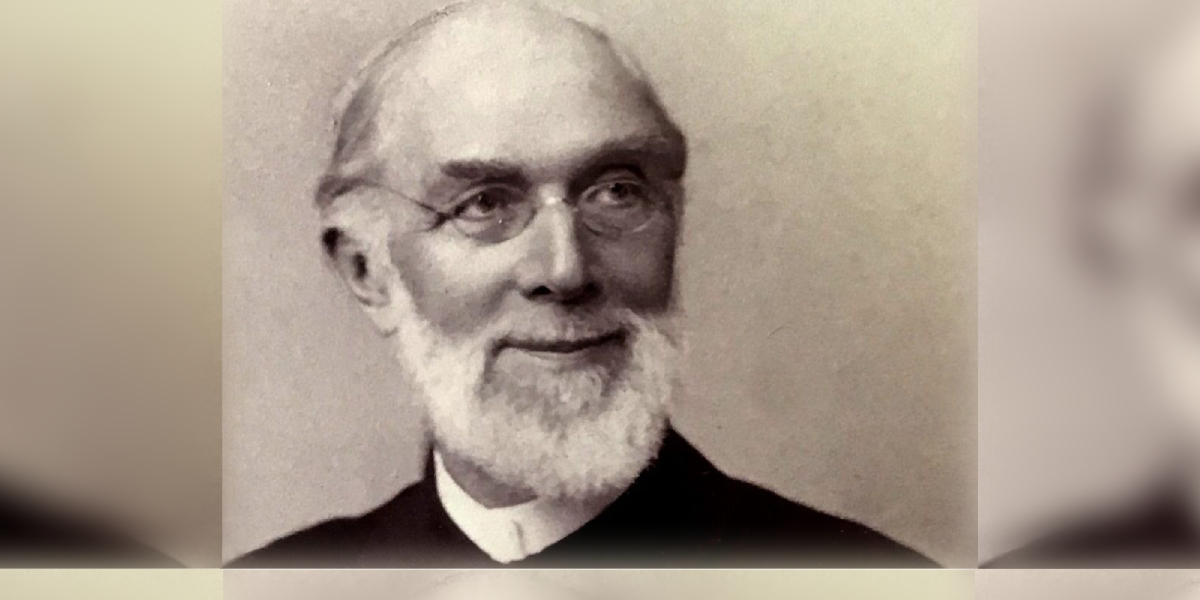
A portrait of Kittel in his old age (Padmanabha Kekunnaya)
‘Only one Kittel for Kannada!’ But why just Kannada; only one Kittel for the whole family of Dravidian languages. Because no other Dravidian language found a lexicographer (i.e. compiler of a dictionary) of comparable quality to Ferdinand Kittel. This is Kannada’s good fortune.
Like Kittel for Kannada, Tamil and the other major Dravidian languages also had their important lexicographers. There is also another piquant matter: the credit for compiling dictionaries for Indian languages, especially Dravidian languages, goes to German Christian missionaries.
Before Kittel prepared his Kannada-English dictionary, there were a number of Kannada dictionaries that had already been prepared using the classical Indic lexicographical method.
Among these were Ranna’s ‘Rannakanda’, Nagavarma’s ‘Abhidhaanavastukosha’, Keshiraja’s ‘Shabdamaṇidarpaṇa’, and Virakta Tontadarya’s ‘Karnataka Shabdamanjari’. But none of them was suitable or practical for the time.
What was needed were dictionaries based on modern methods of lexicography. Such dictionaries were first given to us by German missionaries. Like Kannada had Kittel, Tamil had Winslow, Malayalam had G Gundert, Telugu had Charles Philip Brown, and Tulu had August Manor.
Of the different dictionaries prepared by these different lexicographers for the five main Dravidian languages, there is absolutely no doubt that Kittel’s Kannada-English dictionary is the pre-eminent one.
Kittel was born in Germany. His father was Gottfried Christian Kittel, a missionary. His mother was Helen. Christened Ferdinand, Kittel was born on 7 April 1832 in Resterhafe, in the northern part of Germany. He finished his primary schooling in his hometown and his high school in the neighbouring town of Aurich.
But Ferdinand did not have much taste for formal school education; he was more interested in theology. Consequently, once he’d finished school, he studied for three years at the Basel seminary.
Finishing that, he became a (travelling) missionary and was sent by the mission to India in 1853, at the age of 21. Upon arriving in India, Kittel began his work in Dharwad. To carry out his missionary work, he had to begin by learning the Kannada language.
Though learning Kannada was a necessity at the start, as time went by, Kittel soon became aware of the Kannada language’s beauty and, surrendering to it, used his dedication and passion to learn the language well.
In a short time, not only did he become adept at Kannada, but he also established an unusual mastery of its literature. In a manner of speaking, the Kannada language became an ‘intoxicant’ to Kittel.
Like with all intoxicants, to begin with – a savouring of it for pleasure, then addiction, finally servitude. This was exactly what happened to Kittel. What we see is that a study that began as Kannada for proselytisation’s sake later reached the stage of proselytisation on behalf of Kannada!
This was possible because the missionaries who sent him to India to proselytise recognised the value of his work on Kannada and relieving him of his missionary duties, allowed Kittel to devote himself entirely to Kannada.
This decision was definitely a ‘blessing in disguise’ for Kannada. For, if Kittel had not been relieved of his missionary duties, Kannada might never have gained such a pre-eminent lexicographer.
Having begun his work in Dharwad, Kittel then worked for several years in Mangalore and Madikeri. He also spent some time working in Hubli and Anandapura.
During his time in Mangalore, Kittel married Pauline F. Eyth, a German woman, in 1860. It was a happy marriage and produced two children. However, in 1864, Pauline’s sudden demise came as a grievous shock to Kittel. After spending two more years in Mangalore, he returned home with his two children in 1866.
But, having done so, he returned to India a year later, possibly on account of his fascination for the country. By this time, he had remarried. His second wife was his first wife’s younger sister, Julie W. Eyth.
As we have already seen, Kittel initially needed Kannada only for proselytising. He learnt Kannada for that purpose alone. Having tasted of Kannada’s sweetness, Kittel learnt enough Kannada to read and understand some poems in Kannada.
Subsequently, he began to collect handwritten copies of poems in every place his missionary work took him to and proceeded to study them. Kittel was so moved by the rhythm, the conceits, and the beauty of these poems that he decided they were the best tools for proselytisation.
He went on to write poems in the Bhamini Shatpadi and other similar metres and achieve some success in reaching people through them! One of the poems he wrote was a narrative poem about Christ called ‘Kathaamaale’. Here is a shatpadi (sestet) from the narrative’s 14th episode, composed by Kittel in the desi style.
ಪಾಪಸಾಗರ ದಾಟಿ ಸಗ್ಗಕೆ
ಪೋಪ ಹಡಗವನೇಸು ವೊಡೆಯನು
ಕಾಪುಕಾಯ್ವುದು ಕಾಯದಿದ್ದರೆ ಕೇಳಿರಾಳುಗಳೆ ।
ದೀಪವಿಲ್ಲದ ಗಾಢದಿರುಳಲಿ
ಶಾಪದಲೆಗಳು ಹೊಡೆದು ಒಡೆಯಲು
ತಾಪದಿಂ ನೀವಲೆಗಳೊಳ್ ಮುಳುಮುಳುಗಿ ಹೋಗುವಿರಿ ॥
paapasaagara daaṭi saggake
pōpa haḍagavēsu voḍeyanu
kaapukaayvudu kaayadiddare kēḷiraaḷugaḷe |
deepavillada gaaḍhadiruḷali
shaapadalegaḷu hoḍedu oḍeyalu
taapadim neevalegaḷoḷ muḷumuḷugi hōguviri ||
‘Danielanu Mattu Avana Jothegaararu (Daniel and his Followers)’ was Kittel’s first work in Kannada. Later, his song collection, ‘Kannada Sangeethagaḷu’, his translations from the Bible, were useful as hymns to be sung in church. Overall, Kittel’s contribution to the mission was the creation of more than 700 poems and a number of stories in Kannada.
In 1863, Kittel published ‘ಪರಮಾತ್ಮಜ್ಞಾನ (Paramaatmagnyaana: Knowledge of the Supreme Spirit)’ in Kannada. In 1864, he published the translations, ‘Kannada Panchatantra’, ‘Englandina Itihaasa’, and ‘Hindu Deshada Itihaasa’for children.
Then, in 1865, he was the editor of the works ‘Yēsu Kristana Shramecharitre’ and ‘Saṇṇa Karnataka Kaavyamaale’, again for children. 1866 and 1870 saw the publication of the translated works, ‘Hale Kannada Sankshēpa Vyaakaraṇa Sootragaḷu’ and ‘Christana Sabhaa Charitre’ respectively.
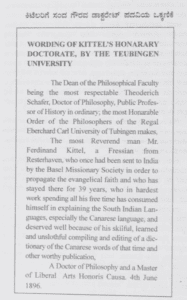
A page showing the text of the honorary doctorate awarded to Kittel by Tübingen University (Supplied)
In summary, Kittel whose purpose of learning and using Kannada was to support his missionary work would eventually find the purpose turned on its head. That is to say, he would come to regard his missionary work as incidental and his Kannada work as his life’s supreme goal. Kittel would end up devoting his entire life to the achievement of this goal.
The aforementioned literary works were what first emerged from Kittel’s pen. These were works written for the common (Kannada speaking) man and for first-level learners. But Kittel was not content with just this. Making Madekeri his base, he began to get more and more involved in his Kannada work.
After collecting nine edited handwritten works from different parts of Karnataka and examining them thoroughly, he edited and published the first-ever modern and systematic edition of Keshiraja’s ‘Shabdamanidarpana’ in 1872, accompanied by a commentary by Nishtura Nanjayya. Kittel himself wrote a scholarly introduction to the work.
Then, in 1875, with the help of 14 different handwritten copies, he edited and published a modern work titled ‘Nagavarmana Chandassu’. Kittel’s ‘An Essay on Canarese Literature’ that was included in this book was a critical appraisal of Kannada literature up to the 19th century. As the first ever essay that gave a view of Kannada literature, Kittel’s essay also has historical significance.
Using the notes he’d made during his work on Keshiraja’s ‘Shabdamanidarpana’ as the basis, Kittel later published the English tract, ‘A Grammar of the Kannada Language’, in 1903. Meanwhile, Kittel’s ‘Ueber den Ursprung des Lingkultus in Indien’ published in 1876 was a German-language work on the worship of the linga.
Here is a list of Kittel’s important works –
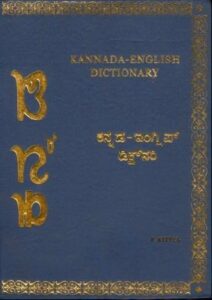
The front cover of Kittel’s ‘English-Kannada Dictionary’ published by ‘Asian Educational Services’ (Supplied)
Of all these important works that Kittel gave to Kannada, the glittering crown-jewel of the collection is his 1894 work, ‘A Kannada-English Dictionary’.
Upon seeing the various scholarly works Kittel had produced on account of his dedication to and interest in Kannada, the head of the Basel Mission suggested to Kittel in 1872 that he consider compiling a dictionary for Kannada.
To make it convenient for him to do so, he relieved Kittel of his missionary duties. When they heard of the new responsibility Kittel had taken on, both Rev Moegling and Rev Elliot wrote letters of encouragement to him.
Kittel had begun to collect Kannada words right from when he’d begun to learn the language. In addition, Kittel’s special affection for Kannada and his acquaintance with a number of ancient poetical works allowed him accept this special assignment with pleasure. Having accepted it, he got down to the grind of preparing a dictionary.
Lexicography is no easy task. A deep and scholarly understanding of the classics, a mastery of the language for which the dictionary is being made, a knowledge of linguistics, sincere effort, a passion for the work, determination, unshakeable faith – these are all prerequisites. Luckily for Kannada, Kittel possessed all these qualities.
When Kittel began his work on the Kannada-English dictionary, he had before him as exemplars some dictionaries prepared by other missionaries, both for Kannada and for the other Dravidian languages.
The ‘A Dictionary, Canarese and English’ (1832) prepared by Rev W Reeve, ‘A Dictionary, Tamil and English’ (1834) prepared by Rev Rottler, AD Campbell’s ‘A Dictionary of the Teloogoo Language’ (1821), CP Brown’s ‘A Telugu-English Dictionary’ (1852), A Manor’s ‘Tulu-English Dictionary’ (1888) were among those Kittel consulted.
Monier Williams’ ‘Sanskrit English Dictionary’ (1872), Rev Gundert’s ‘Malayalam-English Dictionary’ (1872) and Caldwell’s ‘A Comparative Grammar of the Dravidian or South Indian Family of Languages’ (1856) also proved helpful.
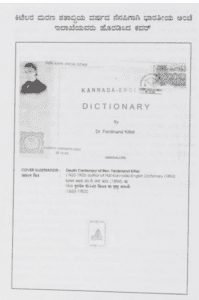
An envelope cover issued by India Post commemorating Ferdinand Kittel’s 100th death anniversary (Supplied)
A critical analysis of all these dictionaries helped Kittel decide, right at the beginning, the form his Kannada dictionary would take. (Usually, lexicographers do not know what form their dictionary will take when they first begin to work on it. As work progresses, not only does the dictionary begin to change form and grow larger, it is common for the final form to be vastly different from the originally conceived form. That Kittel did not experience this problem is unusual.)
Not only did his preparation allow Kittel to decide the dictionary’s form, it also allowed him to chalk out a lexicographical method of creation that was suitable, effective, and all-encompassing. Before Kittel’s dictionary, the Kannada dictionaries that had been published were all either unsuitable, incomplete, mistake-ridden, abbreviated, or unscientific.
This meant Kannada was in need of a dictionary that was faultless, precise, and scientific in order to felicitously reflect the language. This critical (and liminal) period was just the right time for a special sort of Kannada dictionary, which is exactly what Kittel provided.
With a fixed form in mind and sufficient prior preparation, Kittel formally began the work of compiling the dictionary in 1872. In his preface, Kittel describes the material he based his dictionary on. In it, he lists the eight primary sources.
They were:
– 18 works from Halagannada (Old Kannada)
– 18 works from Nadugannada (Middle Kannada)
– some works from Hosagannada (Modern Kannada),
– collected proverbs from the different regions of Karnataka (including what are now Old Mysore, South Canara, and North Karnataka),
– non-Sanskrit desi and rustic words in currency among Kannada speakers,
– the Dravida-English dictionaries of Brown, Reeve, Campbell and others
– the Sanskrit-English dictionaries compiled by people like Monier Williams, Colebrook, etc.
– a Marathi dictionary
With all these sources, Kittel began his work in earnest. He read every tract thoroughly, paying attention to every single word. For every word and reference, he noted down the reference number in the original work.
Besides this, he also took the help of his colleague Rev Zeigler to collect the names of plants and roots and the help of Vastrada Shivalingaiah, a school teacher in Hubli, to collect colloquial words from the region.
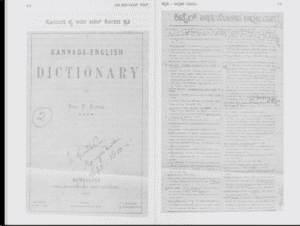
A photo of a page from Govinda Pai’s copy of Kittel’s dictionary (including revisions in Pai’s handwriting) (Supplied)
Having done all this, he began to compile and fit all these words into his dictionary. In just 15 years, a handwritten manuscript of the dictionary was ready. Kittel has written in detail about the dictionary’s form, the arrangement of the words in the dictionary and other related matters in his foreword.
Kittel’s foreword is a long and detailed one. In it, he has discussed the Kannada language, the books he referred to, the dictionary’s system, the transliteration of the Kannada script, the Dravidian elements present in Sanskrit dictionaries, etc. At the very end of this foreword, he has included a list of 420 words that he believes are of Dravidian origin and were borrowed by Sanskrit.
As one digs deeper into Kittel’s dictionaries, some of its special qualities reveal themselves. When the main entry is a word of Dravidian (non-Sanskrit) origin, it has been given in 12 point antique bold font.
On the other hand, words originating from Sanskrit or other languages are given in 10 point normal font. This method is a very helpful way of distinguishing between Dravidian words and non-Dravidian words. Furthermore, the presentation of Dravidian words in bold 12 point font is a clear way of signalling their importance.
Right after the main Kannda entry is the word’s English (or Roman) transliteration and its pronunciation. One can see the distinction between Dravidian and non-Dravidian words here too.
Following this are all the variations of the word. These have been given in 10 point font. What follows them is the explication. The meaning(s) of the main entry have been given in English.
When a word has more than one meaning, these meanings have been numbered and given separately. The distinction in the presentation of Dravidian and non-Dravidian words among the main entries has been followed in the presentation of their meaning too.
After this, if the main entry happens to be a Dravidian word, its Sanskrit equivalent has been given in parentheses, with a reference to the page number of the dictionary where the word is from originally.
So, what is the position of Kittel’s dictionary, replete as it is with several distinctive qualities? By the time Kittel came to compile his dictionary, a couple of Kannada-English dictionaries had already been compiled using the modern method. We have already mentioned their failings.
Consequently, when Kittel began, his goal was to compile a dictionary that was as modern, scientific, and flawless as possible. We can say he achieved his goal.
In fact, his close analysis of tens of classical works and his fieldwork in pursuit of Kannada words led to failing eyesight and the worsening of his health.
In order to get better, Kittel returned to Germany in 1878 and began to prepare the handwritten manuscript there itself. But the many doubts that arose at the time brought him back to Karnataka.
In any case, the handwritten manuscript was ready to be sent to print by 1888. If one realises that it took just 15 years (from when he started work on the dictionary) for Kittel to get to the stage where such a enormous and comprehensive manuscript was fully prepared, one sees how no amount of praise can do justice to Kittel’s dedication to the project.
As a matter of fact, no other Dravidian language can boast a dictionary of this sort. Yes, Winslow compiled a Tamil dictionary. It contains an English explication and few example usages. It also, like Kittel’s dictionary, includes sub entries. However, its sub-entries are not as felicitous as those found in Kittel’s dictionary. One also does not find in it the wide-ranging preparatory work and textual analysis that one finds in Kittel’s dictionary.
Very similar in nature to Winslow’s dictionary is Gundert’s Malayalam-English dictionary. August Manor’s Tulu English dictionary and CP Brown’s Telugu-English dictionary hold even fewer details than these two dictionaries. They contains word meanings, a few sub-entries, some incidental examples of the word’s usage.
In Manor’s case, outside of the Bible in Tulu translation, there were hardly any other Tulu works to be found, a matter that naturally limited the extent of his work. Furthermore, none among Winslow, Gundert, and Brown show the deep knowledge of the literary and philosophical works of their languages as Kittel does of Kannada.
In summary, none of these other lexicographers studied the literature and philosophy of their language as extensively as Kittel studied Kannada’s literature and philosophy. Consequently, there is absolutely no doubt that Kittel’s Kannada-English dictionary is more comprehensive and more scientific in its presentation than any of theirs.
It was recognising this that Hultsch, a scholar and researcher, generously praised Kittel’s dictionary, saying – ‘No other vernacular of India can boast of a more accurate, scientific and orderly dictionary as this one.’
It was 72 years after the first publication of Kittel’s dictionary that Madras University brought out an enlarged and updated version of the dictionary. The editor of the books, M Mariappa Bhat has said, “In the world of Kannada lexicography, Kittel’s name will remain immortal. No student of Kannada literature or Dravidian linguistics can afford to be ignorant of his monumental Dictionary.”
In the case of Kittel’s dictionary, perhaps it is best to regard the dictum, ‘Talk is silver but silence is golden’.
However, a matter that has not been mentioned is what elevates this work to even further heights. Namely, that more than 120 years after Kittel’s dictionary was first published and with infinitely more resources at hand (including computers and money and people), we Indians, especially we Kannada people, have not been able to compile a dictionary that surpasses Kittel’s dictionary!
Yes, the ‘Kannada Sahitya Parishat (Kannada Literature Council)’ has published extensive, deeply-researched, multi-volume dictionaries, but they will never be able to reach nor affect as many people as Kittel’s dictionary. Why? Because they are all monolingual dictionaries, useful only to Kannada readers.
Kittel’s, on the other hand, is a bilingual dictionary. That is its real glory. What is more, since no amount of praise can adequately express the magnitude of Kittel’s effort, I will not say any more. However, recognising Kittel’s monumental effort in preparing this dictionary, Germany’s Tübingen University conferred an honorary doctorate on him on 4 June 1896.
While conducting a critical examination of Kittel’s dictionary, the scholar Fleet recognised Kittel’s immense scholarship and capacity and advised him to write an English book on Kannada grammar. The result was ‘A Grammar of the Kannada Language in English’.
Published by the Basel Mission Press, Kittel rejoiced at seeing a copy of the published book. A day after he had seen the published work, Kittel would slide into everlasting sleep on 19 March 1903. And so it was that the curtain was drawn on the Age of Kittel.
I do not know the kind of honours that Karnataka’s universities conferred on Kittel for his tremendous work, work done by an ordinary foreigner that was beyond the ability of most Kannada scholars.
But Tamil Nadu’s Madras University paid him just tribute when it reprinted a revised and expanded version of his dictionary. Not only that, it also provided an invaluable resource to every person curious about Dravidian languages.
Revised, expanded and edited by Prof Mariappa Bhat, the dictionary was published in four volumes by Madras University in 1968. Prof Mariappa’s contribution justly earned him the title ‘Abhinava Kittel’ (~Modern-day Kittel).
Kittel was a man who having been born and brought up somewhere, gave his life and his energy for the betterment of the language of a foreign land on the other side of the world. He ‘translated’ himself into Kannada and attained fulfillment in his work. This write-up, then, is my word-offering to the divine consciousness that embodied itself in Reverend Dr Ferdinand Kittel.
(This article is the English translation by Madhav Ajjampur of an essay by Dr Padmanabha Kekunnaya. Dr Kekunnaya, who has a PhD from Mangalore University in Linguistics, is currently working running a DTP business. His PhD titled ‘A Comparative Study of Tulu Dialects’ was written in 1991 and published by the Govinda Pai Research Centre in 1994 and won the best book award from the Tulu Karnataka Sahitya Academy in 1995. From 1982-1997, he was the assistant editor for the ‘Tulu Lexicon’ published by the Govinda Pai Research Centre. His most recent publication is the ‘Tulu (Dravida) Cognate Dictionary’, brought out by Nitte University.)

Jul 25, 2024

Jul 25, 2024

Jul 25, 2024

Jul 24, 2024

Jul 24, 2024

Jul 23, 2024